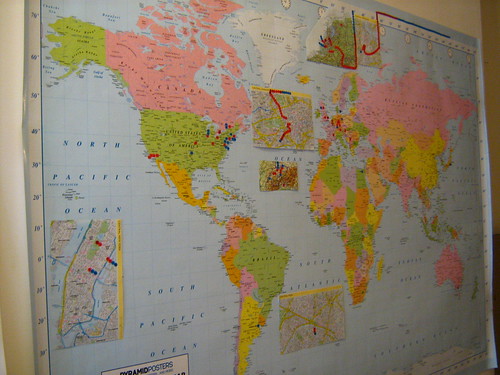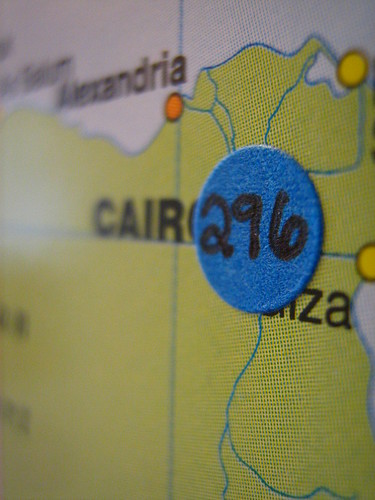Vincent’s Map
Today, I am going to show you all something I’ve been meaning to show you for some time! My (and Vincent’s) Map.
Firstly, I must admit it is not finished but is in fact a work in progress.
Secondly, I must explain. As my research progressed, I became increasingly curious as to where all of Vincent’s paintings were. I was often rocked by the locations inscribed on certain pieces — Hiroshima, Kansas, etc — and eventually gave in to my curiosity and my slightly obsessive nature. I bought the largest wall map I could find for a decent price, and a book of his complete paintings. Then I began.
Soon, I had to make many decisions. How to mark the paintings? I settled on small stickers because that would make the whole piece easily transportable (I started this project a year ago when I was in New York City, but knew it would come with me to Chicago). When I bought a pack, they came in a few colors, so then I decided to color-code them. I also decided to number the paintings in the order the book had them (which is more or less chronological, but also arranged to make sense to a reader) and actually mark the numbers in the book so that they could be cross-referenced. So: you can wonder, what is painting 184 in New York City? And quickly flip through the book and find it. You can also flip through the book, choose a painting, and quickly find the sticker for that painting.
For certain museums, like the Van Gogh Museum or the Kröller-Müller Museum, there are hundreds of paintings/stickers, so I decided to do a few detailed insets and long trails of paintings to represent these larger collections. I bought a second-hand atlas and started cutting.
Who knew there would be so many in Switzerland? Not me. But now I know to plan a trip there!! Oh, and the color coding differentiates time periods and also what I would call the three main stylistic periods of his work:
Red: Paintings done in the Netherlands and Belgium. His “dark period” (1880-1886)
Blue: Paintings done in Paris. His experimentation and impressionistic period. (1886-1887)
Yellow: Paintings done in Arles, Saint-Remy and Auvers-sur-oise, France. His coming into his own, or post-impressionistic period. (1888-1890)
Now these photos are from last summer, and the map has progressed since then, I’ve gotten into the Yellows and the 600s (he painted over 900 paintings!) and I’m pretty excited because now I’m getting to the locations of my favorites.
In general, however, I love to see how his paintings have spread across the world, and it makes me so happy to see how many have access to his paintings, and care to own them. I don’t think he ever could have imagined any of this, but I imagine that yes — it would have made him very happy. It also proves to me that without a doubt, his story is one of success.
This map will be used during my play this summer, and will also be on display afterward for visitors to take a look at. It has become one of my most beloved possessions.
In closing, I’d like to share a little video my brother took of my yesterday. I gave him and a few members of my family a demonstration of what exactly happened to poor Vincent’s Ear. I think it may make you smile, Reader.
Have a lovely week!
[For the curious, I have organized the paintings that are in private collections on index cards according to their country, and once everything is done I will probably attach them along the bottom of the map, just so all pieces are displayed. There is also a sad group of lost or destroyed pieces, World War II being a major culprit. Also — and this really is annoying — this map is only accurate as of 2006, the copyright of the book I’m using. But hey, that’s not SO bad, right?]





I am so happy that I was able to help get this amazing map back to you! I never got to see it but I knew the time & effort you put into this project.
I’m glad to have helped a tiny bit for Vincent & his art :)
The story of how this map came to me is almost as incredible as its genesis. It might be another entry. I feel very lucky to know a few amazing people. Thank you Nicole for being such a wonderful messenger!